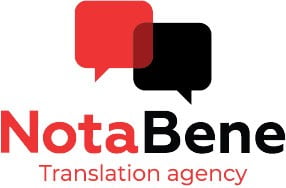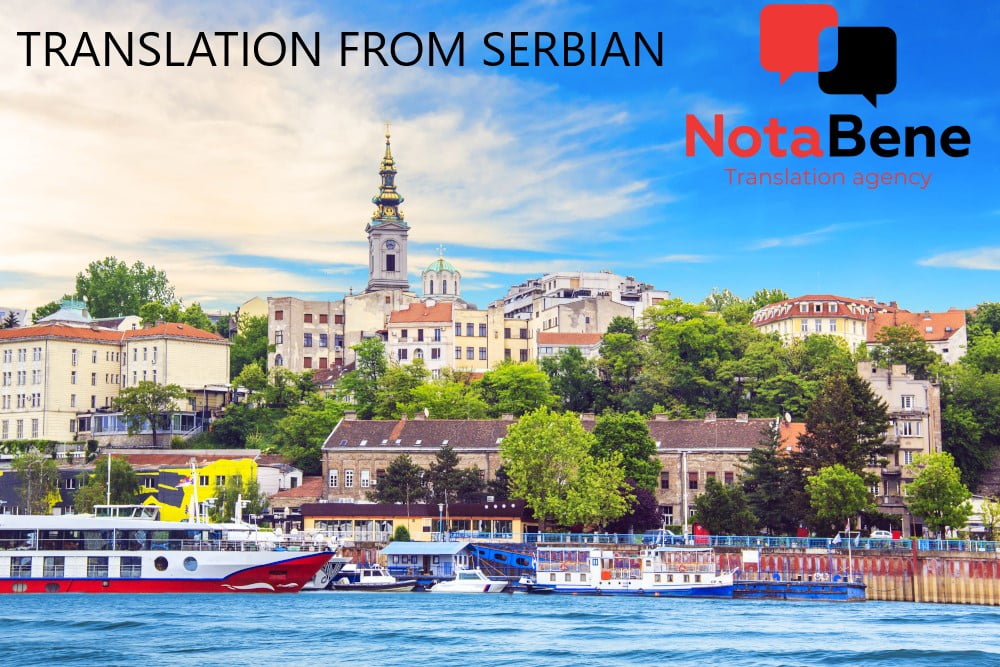Order translation from Serbian or into Serbian at NotaBene Agency in Warsaw and Gdansk!
NotaBene Translation Agency is an experienced supplier of translation from Serbian into Polish and vice versa for any documents or texts.
What types of texts does NotaBene Translation Agency work with?
– Technical translation from Serbian — we translate any texts in electronics, aviation and shipbuilding, agriculture, industry, oil and chemistry, etc. For this purpose, we pick translators who understand the specific nature of a given industry.
– IT translation from Serbian for the localization of applications, games, software and websites.
– Medical translation from Serbian — books, manuals, articles in specialized printed and online publications, clinical records, correspondence with medical institutions, transcriptions and translations of test results, instructions for medicines and many other types of texts. This kind of translation requires flawless knowledge of medical terminology and focus on detail to rule out ambiguity, because the result can affect the health or life of many people.
– Legal translation from Serbian: statutes, registration deeds, articles of incorporation, contracts, powers of attorney, court records and many other similar documents.
– Financial translation from Serbian includes the translation of balance sheets, tax returns, payment invoices, waybills, tender documents, etc.
– Literary or fiction translation is the translation of works of fiction, marketing and advertising materials. Unlike the previous types of translation, in this case there is more room for a translator’s creativity, because there is no need for “word for word” translation. The most important thing is that the translated material produces the same impact as the original, while an excellent translation may even make it better.
Please note that the translation mentioned is certified by an agency seal only. If you need sworn translation, kindly notify your manager in advance. Sworn translation is possible only for certain languages.
How to have a translation from Serbian into English, Polish, Russian, Belarusian or Ukrainian?
First of all, you need to order it. To do so, send your source text and specify your requirements for the translation from Serbian. A customer service specialist at the Nota Bene Translation Agency will prepare a ToR based on the specific features of the order. If the project involves more than one job, a unique glossary is created to ensure the consistency and proper use of terminology.
An entire team of several professionals normally works on a job: a translator, proofreader, editor, quality controller, layout designer and manager who will be available during working hours. In order to rule out human errors, the translation agency uses modern services to check punctuation, idioms, numerical expressions, and formulas. The material is also reviewed by the chief editor.
Confidentiality of translated data is ensured by a special NDA, whenever a customer wishes to have one. Documents can be delivered to any country.
We very rarely apply additional fees for “urgency” or “specialized subjects”, so you can be sure that the price will not rise when the project is delivered. It is true that in rare cases, such as “we need to have it yesterday” instances, and when a customer is willing to pay a higher rate for the team to work outside normal working hours, at night or on weekends, the fee might be increased, but this is always negotiated with the customer in advance.
Interesting facts about the Serbian language
Serbian language, along with Bulgarian, Slovenian, Macedonian, Croatian, Bosnian and Montenegrin, is included in the group of South Slavic languages. The total number of Serbian speakers in the world exceeds 12 million.
1. The history of the modern Serbian language is closely tied to its reformer Vuk Karadzic, who in the first half of the 19th century organized a drastic orthography reform that finally separated the Serbian language from the old Slavic language. Karadzic created a new Serbian orthography, called Vukovica, with the basic principle of phonetic “write as you say it, and read as you read it”. In 1850, Serbian and Croatian intellectuals signed the so-called “Vienna literary pact” to create a unified Serbo-Croatian literary language based on Vuk Karadzic’s model.
2. Latin alphabet was officially introduced in Serbia in 1918, when Serbian king Petar I took over the new state of Serbs, Croats and Slovenes and established equal status for the Latin and Cyrillic alphabets. The reason for that was the official establishment of the Serbo-Croatian language in the country, and Orthodox Serbs traditionally used the Cyrillic alphabet, while Catholic Croats used the Latin one.
In earlier times, Serbs used different alphabets for writing: Glagolitic, Cyrillic, Latin and Arabic script. Glagolitic gave way to simpler Cyrillic. Arabic script was used by Muslim Serbs, and Latin script up to mid 20th century, mostly by Catholic Serbs. The subsequent history of the Balkan peoples and the break-up of Yugoslavia led to the division of the Serbo-Croatian language into Serbian, Croatian and Bosnian dialects, which have now become independent languages.
3. Serbian Cyrillic alphabet has 30 letters, each corresponding to one sound. There are 6 unique letters in alphabet: ј – borrowed from Latin, it is pronounced like Russian “ј”; љ – combination of Russian “l” and “ь”; њ – combination of Russian “n” and “ь”; џ – pronounced as merged “æ”; ђ – pronounced as merged “æ”, ћ – pronounced softer than Russian “ch”.
4. There are 27 letters in Serbian Latin alphabet, because three Cyrillic letters љ, њ, џ correspond to lj, nj, dž in Latin alphabet.
5. In Serbian Vukovica there are two “Ch” letters at once. In Russian it is always soft, but in Serbian, soft – Ћ ћ and hard – Ch ch.
6. In contrast to the dynamic accentuation in Russian, the Serbian accent is tonic – a high or low stress is marked by a change in pitch and there are four types of stress: long ascending, short ascending, long descending and short descending. In words of common origin in Serbian and Russian, the stress in Serbian words is usually on a syllable closer to the beginning, e.g. rUka – Serbian, rukA – Russian, vOda – Serbian, vodA – Russian.
7. In Serbian there are 2 forms of the future tense and 4 forms of the past tense, though only one of them, the perfect, is widely used.
8. The names of nationalities and inhabitants of settlements are capitalized: Rus (Russian), Ruskiњa (Russian), Rusi (Russian), Srbin (Serb), Srpkiњa (Serb), Srbi (Serb), Beograђanin, Beograђanka, Beograђani.
9. There are many words in Serbian with missing vowels or very few of them: рт (cape), трг (square), крв (blood), прст (finger), смрт (death), српски(Serbian), брбљив (chatty), etc.
We have been in business for over 20 years and during that time we have learned to work well. Trust us with your translation from Serbian and get a great result at a reasonable price!








